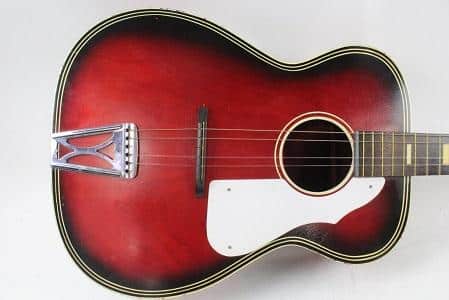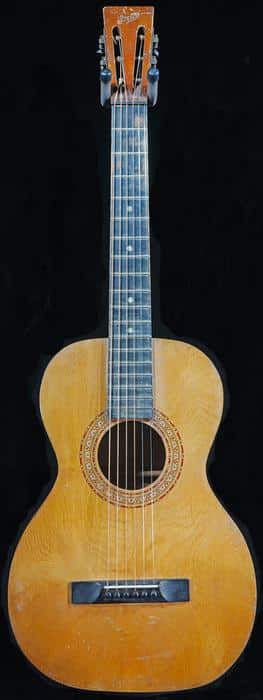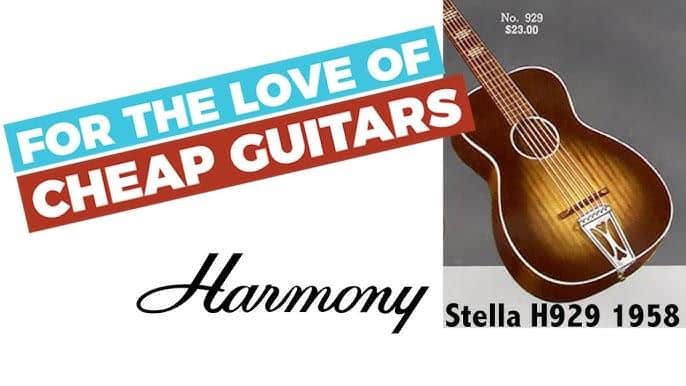Introduction to Stella Harmony Acoustic Guitars
It was a chilly autumn evening when I stumbled upon a worn yet hauntingly beautiful Stella Harmony acoustic guitar at a local antique store. The moment I strummed its strings, I was captivated by its deep, resonant timbre, unlike anything I had heard before. This was not just an instrument; it was a vessel of history and emotion. But what exactly makes the Stella acoustic guitar a cherished gem among musicians and collectors alike?
The tale of Stella and Harmony guitars is not just about their unique, often handcrafted designs, but also about the cultural impact these instruments have made over decades. As I delved deeper into the world of Stella guitars, I uncovered stories of their grassroots popularity among blues and folk musicians, a legacy echoing through time. Join me as I explore the enduring allure and hidden stories behind these iconic guitars, and discover why their legacy persists in contemporary music.
Who Made Stella Harmony Acoustic Guitars?

Did you know that Stella guitars were once considered the ‘working musician’s instrument’ during their peak? This reputation was forged in the early 20th century, a time when these instruments were crafted by the Harmony Company. As a luthier who appreciates their craftsmanship, I find it fascinating how the Harmony Company, established in Chicago, became renowned for producing affordable yet robust instruments that resonated with many musicians across America.
Delving into Stella guitar history, the Harmony Company played a pivotal role in popularizing these guitars from the 1890s until the 1970s. They ingeniously catered to blue-collar musicians who needed reliable guitars that could withstand the rigors of the road without compromising sound quality. This commitment to accessibility and durability is something I deeply respect and often reflect upon.
As an expert who often analyzes the intricate build of these instruments, I am struck by the innovative flair that the Harmony Company embedded in each piece. These guitars were not just instruments but a testament to a rich musical legacy that many dedicated musicians passionately embraced.
What Are the Key Features of Stella Guitars?
Common Models and Variations

With years of experience in instrument design, I’ve seen how certain Stella guitar models capture the essence of both affordability and musicality. Which models have left a lasting mark on the world of acoustic music? Stella’s lineup, celebrated for its affordable acoustic guitars, features models that resonate deeply with musicians and collectors alike. The timeless Stella H929, with its compact size and bluesy tone, has become an icon in the folk and blues genres. Its distinct ladder-bracing design contributes to its unique sound, making it a favorite for those seeking a vintage timbre without breaking the bank. Another standout, the Stella H912, combines durability with a fuller body, offering richer tones that appeal to a broad range of styles. These models exemplify not just the key features of Stella guitars but also why they hold such a cherished place in the history of American acoustic music.
Where to Find and Buy Used Stella Guitars?

As I immerse myself in the rich history of Stella Harmony acoustic guitars, I often find myself reflecting on their enduring charm and timeless appeal. For those of us intent on tracing the legacy of these instruments with the aim to own one, knowing where to find and buy used Stella guitars is crucial. My journey in guitar construction and vintage instrument evaluation has taught me that locating these gems requires both diligence and a keen eye.
How can you ensure you’re getting the best value when purchasing a used Stella guitar? This is a question every enthusiast must ponder. Having worked alongside experts like R.M. Mottola, I’ve learned to prioritize factors such as authenticity, condition, and provenance. Start your search on platforms dedicated to vintage instruments—Reverb, eBay, and specialty guitar shops often have excellent listings. Visit local pawnshops or estate sales for potential hidden treasures.
Engaging with community forums and vintage guitar networks can reveal reliable sellers and insightful advice on guitar value estimation. It’s through these shared experiences and informed negotiations that you can secure a truly valuable Stella guitar. These strategies not only enhance the acquisition process but also deepen your connection to this iconic brand’s history.
When Should You Perform Maintenance on Your Stella Guitar?

Is regular maintenance the key to preserving the sound quality of your Stella guitar? From my extensive experience in lutherie, I can indeed confirm that the answer is a resounding yes. Routine care plays a crucial role in extending the life of your guitar and maintaining its acoustic integrity. Regular upkeep not only enhances the tonal characteristics but also prevents long-term issues that could affect your beloved Stella Harmony acoustic guitar.
In particular, I’ve noticed that many players often overlook the importance of addressing guitar neck issues. These can subtly affect playability and sound quality over time. It’s essential to carry out periodic checks, especially when changes in humidity or temperature could cause the neck to warp or twist.
Ideally, perform a comprehensive maintenance session every six months. During this time, inspect the neck alignment, clean the fretboard, and examine the bridge and nut for wear. This pattern of care ensures that the exquisite sound quality and playability of your Stella guitar are preserved, offering you years of musical pleasure.
Why Are Stella Guitars Considered Valuable by Enthusiasts?

Engaging in the world of guitar enthusiasts is akin to exploring a vast landscape of compelling narratives and musical evolution, with *Stella Harmony acoustic guitars* occupying a sacred niche. As a passionate guitar aficionado who has spent years delving deep into the realm of *luthiers* and collectors, I’ve often marveled at the astounding reverence accorded to these instruments. *What makes vintage Stella guitars coveted among collectors and musicians alike?* This question echoes through the halls of guitar shops and the studious debates of guitar forums. The answer lies in their exceptional build, historical significance, and the soulful resonance they embody.
Stella guitars, often hailed as some of the *best vintage guitars*, were primarily crafted during the early 20th century, a period marked by an explosion of musical innovation. This legacy is fondly remembered by aficionados not just for their unique tonal qualities but for the stories they carry within their strings. The inherent charm of a Stella is more than its auditory allure or the rugged beauty of its design; it is a tangible connection to an era of musical transformation. Drawing from countless *Stella guitar reviews* and personal encounters, their value is an interplay of craftsmanship, accessibility to emerging artists of their time, and a distinct sound that modern instruments strive to replicate.
Indeed, these guitars, with their unique ladder bracing and solid craftsmanship, offer collectors a piece of history. Each instrument reveals traces of artistry that resonate with enthusiasts, enabling even amateur musicians to produce a quality of sound that punches well above its weight. It is this smooth blend of history, accessibility, and artistry that positions Stella guitars as highly prized commodities within dedicated circles. To truly appreciate a Stella is to recognize not just a valued instrument but a hallowed artifact, enriching every collection it graces.
How to Repair Common Issues with Stella Guitars?

What are the most common issues faced by Stella guitar owners, and how can they be addressed? As a practicing luthier with years of experience, I’ve encountered a variety of challenges unique to Stella guitars, beloved for their historical charm and distinctive tonal qualities. These instruments, often passed down through generations, can develop a series of quirks and issues due to age and use.
One prevalent issue is related to the *guitar neck*. Over time, the neck can warp or bow, affecting playability and sound quality. To tackle this, I recommend assessing the neck’s relief. Adjusting the truss rod—a common and crucial method—can resolve minor warps. When handling older Stellas, which may not have a truss rod, more intrusive procedures like heat pressing might be necessary. It’s essential to proceed delicately, respecting the integrity of these vintage treasures.
Another common complication is the bridge lifting due to tension. A repair technique I often employ involves gently removing the bridge, flattening the underlying surface, and regluing it using a robust adhesive designed for musical instruments. This ensures that the bridge can withstand string tension for years to come.
From my experience, understanding these guitars’ intricacies not only maintains their value but also enhances their lush, resonant sound. Fixing common issues like these allows owners to appreciate their Stella guitars in their full sonic glory, adding life to their legacy.
FAQs
What makes Stella Harmony acoustic guitars iconic?
When were Stella Harmony guitars first produced?
Who were some famous musicians associated with Stella Harmony guitars?
Are Stella Harmony guitars still in production?
Conclusion
What can we learn from the legacy of Stella Harmony acoustic guitars? These remarkable instruments, with their rich history and distinctive sound, have left an indelible mark on the world of music. From the meticulous craftsmanship of their makers to their enduring popularity reflected in countless enthusiastic Stella guitar reviews, Stella guitars continue to captivate musicians and collectors alike.
As I conclude my exploration of these iconic guitars, I am reminded of how they continue to *inspire* new generations despite their vintage status. Whether you’re a seasoned musician or a budding enthusiast, the allure of the Stella acoustic guitar still resonates, offering timeless value and joy.

R.M. Mottola, an engineer-turned-luthier, revolutionizes stringed instrument design with his deep focus on acoustics and ergonomics since 1994. As editor of the Savart Journal and a key contributor to American Lutherie, Mottola merges science with artistry in lutherie. He enriches the field with his extensive knowledge, shared through his Liutaio Mottola website, making him a beacon in the world of modern instrument craftsmanship.
